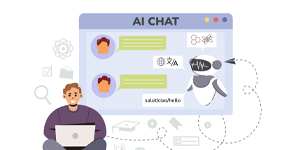DEI Recruitment: Strategies That Actually Work in 2025
In 2025, the world of work needs more than merely filling jobs. It has to provide spaces where everyone feels respected, heard and represented. Diversity, Equity and Inclusion (DEI) recruitment is becoming one of the most important parts of managing people in the modern world. Companies are competing for talent all around the world, and businesses that focus on fair and inclusive recruiting will not only attract but also keep the most creative people.
This essay goes into great detail about DEI hiring methods that will work in 2025. It looks at how businesses may hire more diverse people, set up hiring methods that don't favor certain groups, and follow DEI hiring best practices to make sure that everyone has a fair chance. You will also discover how to make recruiting less biased and see examples of effective diversity and inclusion hiring initiatives that are changing workplace all around the world.
 |
Understanding DEI Recruitments in the Modern WorkplaceDEI hiring isn't just a slogan; it's a long-term promise to hire people who reflect the variety of society. It makes sure that people of all races, genders, background and abilities have the same chances at jobs. |
The purpose of DEI hiring is to make sure that hiring practices respect competence, potential and diversity equally.
As businesses change, hiring people from different backgrounds has been shown to boost innovation, productivity, and employee happiness. Studies regularly demonstrate that organizations that prioritize diversity and inclusiveness in their recruitment processes outperform those that neglect these concepts. In 2025, companies that hire people without bias will be better able to meet the moral and social standards set by both customer and investor.
Adopting DEI hiring best practices means looking beyond traditional hiring methods. It involves developing a transparent and equitable hiring process that minimizes unconscious bias, values cultural competence, and empowers all employees to thrive.
Read more: How to Avoid Bias in Recruitment Tools
The Role of Inclusive Hiring Strategies in DEI Recruitment
Inclusive hiring strategies are the most important part of successful DEI recruitment. These measures are meant to get rid of the factors that keep some groups from getting equal job chances. When done right, inclusive hiring techniques can change the way firms find and keep a diverse group of employees.
To use inclusive recruiting techniques well, companies need to start by checking their hiring systems. This entails looking over job descriptions, interview formats, and evaluation criteria to make sure they don't mistakenly favor one group over another. The first step in learning how to hire people in a way that includes everyone is to find and fix any systemic problems that may be in your company's hiring process.
In addition, executives should get recruiting managers involved in DEI training programs that teach them how to be sensitive to other cultures and communicate without bias. Businesses make sure that every candidate has a fair chance by combining fair hiring practices with inclusive hiring tactics.
Diverse Talent Acquisition: The Heart of a Strong Workforce
1. Understanding the Importance of Diverse Talent Acquisition
Diverse talent acquisition goes beyond hiring people from different backgrounds—it’s about building a workforce that reflects a variety of experiences, ideas, and cultural perspectives. This diversity fuels innovation, creativity, and better decision-making, as employees contribute unique insights that help solve complex business challenges. Companies that prioritize DEI recruitment recognize that diversity is a core driver of long-term success, not just a social goal.
2. Strategies for Building a More Inclusive Hiring Process
In 2025, forward-thinking organizations are redefining how they approach diverse talent acquisition. They collaborate with minority networks, educational institutions, and community organizations to attract candidates from underrepresented groups. These partnerships help companies develop equitable recruitment pipelines and reduce unconscious bias. Moreover, data-driven hiring tools and structured interviews play an essential role in ensuring fair and transparent selection processes.
3. Strengthening Employer Branding to Attract Diverse Candidates
To truly enhance diverse talent acquisition, companies must communicate their inclusion values clearly through their employer branding. Job seekers today want to join organizations that demonstrate authenticity and commitment to equity. Highlighting diversity initiatives, inclusive leadership, and employee resource groups in recruitment campaigns attracts like-minded candidates. By promoting bias-free recruitment and a culture of belonging, companies not only create a fair hiring system but also build a stronger, more resilient workforce.
Bias-Free Recruitment: Eliminating Barriers in Hiring
Bias-free recruitment is the cornerstone of effective DEI hiring best practices. Unconscious biases can subtly influence decisions throughout the hiring process, from resume screening to final interviews. Without proper controls, these biases can undermine even the best-intentioned DEI recruitment programs.
One of the most effective ways to reduce bias in recruitment processes is through blind hiring. This involves removing personal identifiers such as name, gender, or age from resumes during initial screening. In addition, using structured interview questions and standardized evaluation criteria ensures fairness and consistency in assessments.
Technology also plays a major role in promoting bias-free recruitment. AI-powered tools can analyze job descriptions to identify potentially biased language and suggest neutral alternatives. Moreover, data analytics helps HR teams measure progress and evaluate the success of their diversity and inclusion recruitment programs.
Equitable Hiring Practices for Sustainable Growth
Equitable hiring practices go beyond simply offering equal opportunities—they aim to level the playing field for all candidates. These practices address structural inequalities that may disadvantage specific groups during recruitment. In DEI recruitment, equity ensures that everyone has the resources, support, and fair treatment necessary to succeed.
Companies committed to equitable hiring practices in 2025 use transparency as a guiding principle. This means clearly communicating job requirements, pay ranges, and career progression opportunities. When employees see that their workplace upholds fairness, they are more likely to remain engaged and loyal.
To understand how to implement inclusive hiring practices in your company, it’s crucial to establish accountability frameworks. Setting measurable DEI goals, tracking diverse talent acquisition outcomes, and reviewing bias-free recruitment data are key steps. These actions ensure that equitable hiring practices remain at the heart of the organization’s culture.
DEI Hiring Best Practice in 2025
As expectations in the workplace change, so do the best ways to hire for DEI. The best organizations in 2025 use statistics to judge how well their diversity and inclusion hiring efforts are working. These groups know that DEI hiring needs to be planned, tracked and flexible.
implementing inclusive language in job advertisements, making hiring panels more diverse and implementing employee referral programs that focus on underrepresented groups are some of the greatest DEI recruitment technique for 2025. Also, ongoing education and awareness training make sure that worker at all levels know how important it is to use recruiting practices that are open to everyone.
Companies that use DEI measures in performance reviews are example of successful diversity and inclusion hiring strategy. This make sure that people are held responsible and that things keep getting better. Companies may establish a culture that not only embrace but also celebrate diversity by making sure that their DEI recruiting process is in line with their goal.
How to Implement Inclusive Hiring Practices in Your Company
Implementing inclusive hiring practices is one of the most impactful ways to achieve long-term DEI (Diversity, Equity, and Inclusion) success. It’s not just about fulfilling diversity targets—it’s about creating a fair, welcoming environment where every candidate has an equal opportunity to succeed. A truly inclusive hiring process requires leadership commitment, structured frameworks, and continuous evaluation to ensure fairness and representation across all levels of the organization.
1. Establish Leadership Commitment and Clear DEI Policies
The foundation of inclusive hiring starts with leadership. Executives and HR leaders must actively champion DEI initiatives, not just approve them. This includes setting measurable goals, funding inclusion programs, and communicating the importance of fairness across all departments. When leaders model inclusive behavior, it sets a strong example that influences company culture and decision-making.
2. Design Fair and Equitable Recruitment Frameworks
Building an inclusive recruitment framework involves practical strategies that reduce bias and improve diversity outcomes. Examples include creating diverse interview panels, crafting gender-neutral job descriptions, and using structured evaluation rubrics to assess candidates objectively. Companies can also provide inclusive onboarding programs and mentorship opportunities for underrepresented employees, ensuring they feel supported from day one.
3. Continuously Monitor and Improve Recruitment Practices
To keep hiring procedures that include everyone, company need to regularly look at hiring data and results. HR departments should keep an eye on things like the diversity of candidates, the ratio of interviews to hires and the retention of employee across different group. Company can improve their hiring procedure and make their efforts to include more people stronger by finding possible biase or gap in their system. This attitude of always trying to become better makes sure that DEI tactics change with the requirements of the workforce and have a lasting effect.
Real-World Examples of Successful Diversity and Inclusions Recruitment
Many groups throughout the world have set great examples of successful diversity and inclusion hiring programs. These programs show how DEI hiring may lead to new ideas, better teamwork, and a better reputation for the firm.
For example, major tech companies have started using inclusive hiring practices that focus on neurodiverse people because they know they have unique problem-solving skills. Many business has also started mentorship programs to help women and minorities become leaders. These are clear instances of successful hiring program that promote diversity and inclusion.
These efforts also illustrate how important it is to have bias-free hiring processes in order to get fair results. These organizations set an example for others by integrating fair recruiting policies with hiring people from different backgrounds. Their success shows that good DEI recruiting practices are not only good for business, but also good for the environment.
Ways to Reduce Bias in Recruitment Processes
Reducing bias in recruitment processes is essential for building a fair and inclusive workplace. In 2025, many organizations are prioritizing bias-free recruitment as a key pillar of their DEI recruitment strategies. Bias—whether conscious or unconscious—can negatively impact hiring outcomes by limiting diversity and overlooking talented candidates. To create equitable opportunities for all applicants, companies must apply structured methods, technology, and transparency throughout the entire hiring process.
1. Leverage Technology to Minimize Human Bias
Using technology-based screening method is one of the best ways to cut down on bias. These tools use algorithms to fairly judge candidates based on their skills and expertise, not their race, gender, or age. Also, removing names from resumes and employing data-driven evaluations can assist get rid of subjective judgment. When set up correctly, AI-powered system help with hiring method that is open to everyone and make sure that all applications are judged by the same standard.
2. Conduct Bias-Awareness Training for Hiring Teams
Education remains a cornerstone of bias reduction. Companies should conduct regular bias-awareness workshops for hiring managers and recruiters to help them recognize and mitigate unintentional prejudices. Training should cover areas such as cultural sensitivity, inclusive communication, and structured interviewing techniques. When hiring teams understand how bias influences decision-making, they can take deliberate steps toward more equitable hiring practices.
3. Promote Transparency and Accountability in Hiring
Transparency strengthens trust and reinforces a company’s commitment to fairness. Sharing selection criteria with candidates helps ensure that everyone understands how hiring decisions are made. Organizations should also implement continuous feedback loops, allowing both candidates and recruiters to review and refine recruitment processes. By combining openness with accountability, companies create a strong foundation for sustainable diversity and inclusion recruitment, leading to a more balanced and innovative workforce.
Conclusion
In 2025, DEI hiring will be an important part of a successful corporate strategy. Companies that use hiring methods that are fair, open to everyone, and free of bias will do well in terms of both performance and reputation. By using best practices for employing diverse people and DEI, companies may create workplaces that are fair, creative, and equal.
Diversity and inclusion hiring isn't only about following the rules; it's also about making a real difference. Companies can create a culture where everyone has a chance to succeed by understanding how to hire people in a way that is fair to everyone and using proven strategies to cut down on bias in the recruiting process.
Frequently Asked Questions
1. What is DEI recruitment?
DEI recruitment refers to the process of attracting, hiring, and retaining candidates from diverse backgrounds through equitable and inclusive practices that eliminate bias.
2. Why are inclusive hiring strategies important?
Inclusive hiring strategies ensure that all candidates are given equal opportunities, reducing bias and fostering a more innovative and engaged workforce.
3. How can companies achieve bias-free recruitment?
Companies can achieve bias-free recruitment by using blind resume screening, standardized interviews, and AI tools that detect biased language in job postings.
4. What are equitable hiring practices?
Equitable hiring practices focus on providing fair treatment and equal access to opportunities for all candidates, regardless of their background or identity.
5. What are the best DEI recruitment strategies for 2025?
The best DEI recruitment strategies for 2025 include using inclusive job descriptions, diverse interview panels, data-driven evaluations, and continuous DEI training.
6. How can a company implement inclusive hiring practices effectively?
To implement inclusive hiring practices effectively, leadership must be involved, recruitment policies should be reviewed for fairness, and data should be used to measure results.
7. Can DEI recruitment improve company performance?
Yes. Companies that embrace DEI recruitment often see higher innovation, better decision-making, and stronger employee engagement due to diverse perspectives and inclusion.





